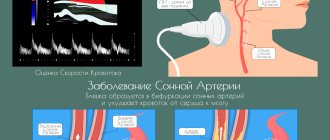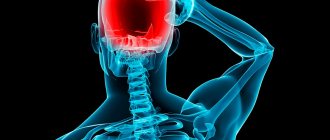- Causes of high blood pressure
- Idiopathic form of the disease
- Symptoms of intracranial pressure
- Manifestations of liquor-hypertensive syndrome in children
- Diagnostics
- Treatment of intracranial pressure
- Drug treatment
Intracranial pressure is otherwise called intracranial pressure.
An increase in intracranial pressure is called intracranial hypertension, which is characterized by a moderate or pronounced clinical picture. This pathology is also known under the names “cerebrospinal fluid hypertension syndrome”, “cerebrospinal fluid hypertension syndrome”. The term “cerebrospinal fluid” refers to cerebrospinal fluid. The disease can occur in an acute form and become chronic. Acute most often occurs against the background of traumatic brain injury (TBI), back injuries and infectious lesions of the brain. Chronically elevated intracranial pressure is observed in patients with brain tumors and cysts, and symptoms increase as the tumor enlarges. The pathology persists after severe surgical interventions, injuries to the spinal cord and brain, inflammatory processes that led to disturbances in liquorodynamics - the circulation of cerebrospinal fluid.
Intracranial pressure is reduced mainly by medicinal methods; surgical intervention is used only in particularly difficult cases.
Causes of high blood pressure
The disease occurs in adults and children. Its causes can be congenital or acquired. They are conventionally divided into four groups:
- Volumetric formations.
This category includes brain tumors, cysts, abscesses, and vascular aneurysms. The tumor takes up space in the skull, compresses certain areas of the brain, and displaces its structures. This leads to a change in intracranial pressure. In young children, intracranial pressure higher than normal may be due to congenital developmental anomalies. Most often, specialists diagnose microcephaly or hydrocephalus. Trauma during childbirth, asphyxia, and oxygen starvation of the fetus can lead to pathology. At risk are babies born prematurely. - Edema.
Characteristic in the development of a number of diseases: encephalitis, meningitis, arachnoiditis, ischemic stroke, as a result of head injury, intoxication, hypoxia. Edema can be local, that is, affecting individual areas of the brain, or diffuse.
- Increased blood supply inside the skull.
This pathology occurs with dyscirculatory encephalopathy and a number of other diseases. In this case, the blood flow increases or its outflow from the vessels supplying the brain becomes more difficult. Due to increased blood supply, blood pressure rises. - Disorders of cerebrospinal fluid dynamics.
In the human body, the brain is surrounded by cerebrospinal fluid (CSF), which moves at a certain speed and affects brain tissue, thereby creating intracranial pressure. Part of the cerebrospinal fluid enters the blood, and the missing amount of fluid is produced to replace this volume. Thanks to this, constant pressure is achieved, which is considered normal. Infectious and inflammatory diseases, back and head injuries lead to various disorders of the secretion and circulation of cerebrospinal fluid. In this case, the absorption of cerebrospinal fluid becomes slow or its production is excessively activated. Liquorodynamic disorders can develop against the background of congenital anomalies in the structure of the spinal cord and brain. Intracranial dystension occurs, in which the pressure on the brain becomes uneven. Excessive accumulation of fluid in the cranium causes compression of individual areas and vessels, which leads to changes in intracranial pressure.
In addition to injuries and inflammation, disruption of the production and circulation of cerebrospinal fluid can cause treatment with potent drugs. At risk are patients who are forced to take hormonal drugs, antibiotics, and corticosteroids for a long time. Excessive amounts of vitamin A due to abuse of retinol preparations can lead to changes in intracranial pressure.
Symptoms of intracranial pressure
You can suspect a problem based on the following signs:
- headache;
- nausea and vomiting in the absence of gastrointestinal diseases;
- increased fatigue;
- irritability;
- changes in blood pressure, pulse rate;
- decreased libido.
Headache is the main symptom of liquor-hypertensive syndrome. Patients note the dependence of pain on body position and time of day. For many people, headaches begin to hurt more severely in the evening and at night, when a person is in a lying or reclining position. In this case, the production of cerebrospinal fluid increases, and its outflow worsens, which increases compression.
There is a feeling of fullness, pressure from the inside, which is localized in the fronto-parietal areas. The patient complains of a feeling as if something is pressing on the eyes from the inside, and blurred vision occurs. This feeling intensifies when the eyeballs move. When examining the fundus, the doctor will note swelling of the optic nerve - one of the main signs of increased intracranial pressure.
Because of the headache, a person feels bouts of nausea, but after vomiting, the state of health does not improve. In severe cases, the disease is accompanied by fainting and confusion.
In the chronic form of the disease, the quality of life decreases significantly. The patient becomes emotionally labile, stress resistance and performance decrease. Many people feel worse when the weather changes, that is, they develop increased meteosensitivity. It manifests itself as headaches and dizziness, sleep disturbances, fluctuations in blood pressure, muscle and joint pain, and general malaise.
Traditional methods of correction
What should patients do to independently stabilize ICP? You can lower the level of cranial pressure at home using folk recipes. It is recommended to use herbs and plants that have sedative and vasodilating properties. However, non-traditional treatment is used for chronic intracranial hypertension in remission.
The following non-traditional remedies will help reduce intracranial pressure:
- Lavender infusion. 1 tbsp. l. place dry raw materials in a container and pour 500 ml of boiling water. Leave for an hour, then remove the sediment. Take 3 times a day, 1 tbsp. l. Therapeutic course - 3 weeks.
- Decoction of bay leaves. To prepare, you need to prepare several leaves, which are filled with 1.5 liters of water. Bring the mixture to a boil and use as inhalation. Course - 14 days.
- Clover tincture. Dried flowers of the plant should be taken in an amount equal to 0.5 liters of container. Fill with alcohol so that the liquid covers the dry raw materials. Leave for 2 weeks, then filter, take the tincture 3 times a day, 1 tsp. The duration of the course is 30 days.
Birch sap has a diuretic effect, due to which it normalizes ICP parameters
Treats intracranial hypertension with a mixture based on honey:
- To prepare, take 150 ml of fresh lemon juice, 350 g. liquid flower honey and 2 cloves of chopped garlic.
- Mix the ingredients thoroughly.
- Leave the mixture in a dark, cool place for 10 days.
- Take in the morning, in the evening 60 minutes after a meal at a dose of 1 tsp.
To quickly eliminate headaches accompanying a hypertensive attack, use lavender essential oil. A few drops of the product should be applied to the temporal area and rubbed in with light massage movements for several minutes.
Manifestations of liquor-hypertensive syndrome in children
In some cases, increased intracranial pressure in children does not manifest itself with pronounced symptoms. This is due to the fact that the skull bones of newborns are softer, so hypertension is compensated.
With severe disturbances, it manifests itself as tearfulness and anxiety, sleep disturbance. The newborn refuses to feed and often spits up after feeding. A typical sign of increased intracranial pressure in a child is “protrusion” of the fontanelle. Compression of certain areas of the brain negatively affects the physical and intellectual development of children. In addition to behavioral disorders, disorders of vital functions and delayed psychophysical development are possible. In severe cases, the result of prolonged intracranial hypertension in a child is the formation of mental retardation.
Drugs that improve blood circulation in brain tissue
The main reason why intracranial pressure increases in adults is spasm of blood vessels as a result of their sudden compression and insufficient blood supply. To eliminate the symptoms of intracranial pressure, it is necessary to take drugs with the opposite effect - dilating the capillaries of the brain and accelerating the blood supply to brain cells.
Doctors recommend that patients take the following medications:
- Phenotropil;
- Nootropil;
- Encephabol;
- Sermion;
- Actovegin;
- Piracetam.
This list of tablets is not suitable for independent use at home; such drugs should be prescribed exclusively by a doctor, prescribing the frequency and dosage for each specific patient individually. Means that can be used independently with caution are Aspirin, Pantocalcin (Pantogam), Glycine and Gingko Biloba. In this case, you need to thoroughly study the instructions for use and not exceed the recommended dosages.
Diagnostics
If there are signs of liquor-hypertensive syndrome, you should make an appointment with a neurologist. To make a diagnosis, the doctor prescribes a set of procedures:
- fundus examination;
- echoencephalography;
- X-ray of the skull;
- CT or MRI of the head
- Ultrasound of blood vessels supplying the brain;
- angiography.
In severe clinical cases, the doctor may prescribe a lumbar puncture, which helps determine accurate indicators of intracranial pressure.
The purpose of these procedures is primarily to identify the cause of hypertension. Based on the data obtained, the specialist determines a treatment regimen and prescribes additional diagnostics.
External methods of stabilizing ICP
In alternative medicine, there is a wide list of effective external methods that can provide first aid for intracranial hypertension:
- Bath with linden. It is necessary to take baths with linden decoction in a sitting position, so for preparation you need to take 4 cups of dried raw material per 10 liters of hot water.
- Rubbing the ears with cool water. The procedure is repeated many times until you feel better.
- Foot bath with mustard. Place 2 mustard plasters in hot water, lower your feet and soak for 15-20 minutes.
To stabilize the condition, craniosacral therapy is used, which consists of influencing certain points located in the temporal and occipital regions. Due to the gentle effect on the skull, ICP decreases and well-being improves.
High intracranial pressure is a dangerous condition, as it can lead to the development of emergency complications, including death. To stabilize it, there are a large number of medications and folk remedies that can eliminate the manifestations of pathology, but they do not affect the main etiological factor. Therefore, if signs of the disease occur, it is necessary to visit a specialist for diagnosis and further selection of the optimal treatment regimen.
Treatment of intracranial pressure
Conservative and surgical methods are used to reduce intracranial pressure. The operation is performed if the cause of the disorder is a tumor, cyst, or congenital abnormality of the brain structure. Removing the tumor eliminates compression and normalizes blood pressure. To eliminate hydrocephalus, the cerebral shunt technique is used.
The operation can be performed planned or urgently. Emergency intervention is carried out in severe forms of the disease, when it can lead to dislocation syndrome. This is a dangerous complication in which cerebral structures are displaced due to compression. The cerebellar tonsils are wedged into the foramen magnum, and the brain stem is compressed. It includes important nerve centers responsible for respiratory function and heart function. Damage to these areas poses a threat to life.
Drug treatment
In most cases, medications are selected for the patient to normalize intracranial pressure. These include:
- osmodiuretics;
- diuretics;
- potassium preparations;
- detoxifying agents;
- antiviral agents and antibiotics to eliminate the infectious and inflammatory process;
- vascular drugs;
- neurometabolic agents.
Based on the results of a comprehensive diagnosis, the doctor may prescribe magnesium sulfate for injection or piracetam for injection.
Attention! The selection of drug treatment for intracranial pressure is made by the doctor based on the diagnosis and after the diagnosis is made. To normalize the condition, it is important for the patient to reconsider his lifestyle, adjust his daily routine, and avoid psycho-emotional overload. Moderate physical activity is beneficial: walking, swimming.
Prognosis for liquor-hypertensive syndrome directly depends on the cause of its occurrence. With timely treatment of neuroinfections and liquorodynamic disorders, good dynamics and results can be achieved.










